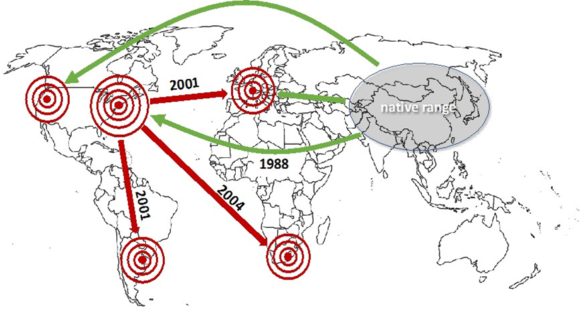Invasion science must adapt to meet growing societal demands and biosecurity challenges in the face of rapid global environmental change.
This task was addressed at a workshop during the NEOBIOTA conference in Dún Laoghaire, Ireland, in September 2018 that was attended by several researchers affiliated with the Centre for Invasion Biology (C∙I∙B).
A publication in the journal Environmental Reviews, led by C∙I∙B associate Anthony Ricciardi of McGill University in Canada and with several other C∙I∙B researchers as co-authors, summarizes the findings of this workshop and subsequent deliberations. The paper identifies four critical priority areas that need to be addressed by the field (Figure 1).

One priority area is the need for novel methods to forecast the ecological impacts of invasions. Risk assessments of invasions are confounded by environmental context dependencies and lag times between introduction and impact. A related priority area is to understand how invasive species interact with multiple stressors, particularly climate change. The researchers suggest that the innovations in theory and methods required to address these issues could be found by exploring linkages with other disciplines. For example, factors promoting the emergence and spread of novel infectious diseases might be better understood through collaborations between biomedical researchers and invasion biologists.
Another critical issue is the steady global decline in taxonomic expertise. If not reversed, this will lead to increasing misidentifications and impaired detection of invasion threats. The erosion of our capacity to recognize biodiversity and distinguish non-native from native species poses severe consequences for biosecurity that cannot be adequately mitigated by new molecular technologies alone. The problem is especially worrying in marine ecosystems and for microorganisms in general.
“Scientific understanding of the processes that control the diversity, abundance, and distribution of non-native species depends upon the quality of taxonomic data. We now face a critical and mounting predicament on this front: The steady global erosion in training and expertise in systematics means that we simply lack the taxonomic support to accurately identify many, if not most, taxonomic groups in freshwater, terrestrial, and marine habitats,” – explains one of the co-authors, James T. Carlton.
Taxonomic expertise should be cultivated through infrastructure support (such as cybertools and properly curated specimen collections) and by re-establishing training programmes focussing on both classic and advanced taxonomic skills. Governments and academia must employ qualified taxonomists to handle the burden of increasing rates of invasion by a wide range of organisms transported across the planet through human activities.
Finally, the authors call for enhanced international cooperative biosecurity. Contemporary national biosecurity programs are generally designed to protect the interests of individual countries and scant attention is given to the “greater good”—that is, protecting all nations from invasions. A key consideration is the tendency of spreading organisms to invade new regions from locations in which they have already established (“bridgeheads”)(Figure 2). The implication of this phenomenon is that successfully preventing a species from invading a bridgehead region will bring benefit to multiple countries elsewhere in the world by reducing its opportunities to spread within a global dispersal network.

“We must recognize invasions as a challenge to global biosecurity”, says Ricciardi. “The world’s recent experience with the SARS-CoV-2 virus provides an excellent, albeit extreme, example of the bridgehead phenomenon. Cooperation among countries to eradicate or control invasive species in key bridgehead regions should yield broad international benefits.”
Overall, invasion science must continue to evolve. This paper offers some guidance on how the field should adapt to an era of burgeoning human influence, novel stressors, and rapid environmental change.
“Lessons learned from deliberations during the preparation of this review have been extremely useful and are being applied in reshaping the research agenda at the Centre for Invasion Biology,” says C∙I∙B Director Dave Richardson, a co-author of the paper.
Read the paper in Environmental Reviews
Ricciardi, A., Iacarella, JC., Aldridge, DC., Blackburn, TM., Carlton, JT., Catford, JA., Dick, JTA., Hulme, PE., Jeschke, JM., Liebhold, AM., Lockwood, JL., MacIsaac, HJ., Meyerson, LA., Pyšek, P., Richardson, DM., Ruiz, GM., Simberloff, D., Vilà, M. & Wardle, DA. 2021. Four priority areas to advance invasion science in the face of rapid environmental change. Environmental Reviews. Volume 29 (2). Pages: 119 – 141. DOI: https://cdnsciencepub.com/doi/10.1139/er-2020-0088
For more information, contact Prof Dave Richardson at rich@sun.ac.za



